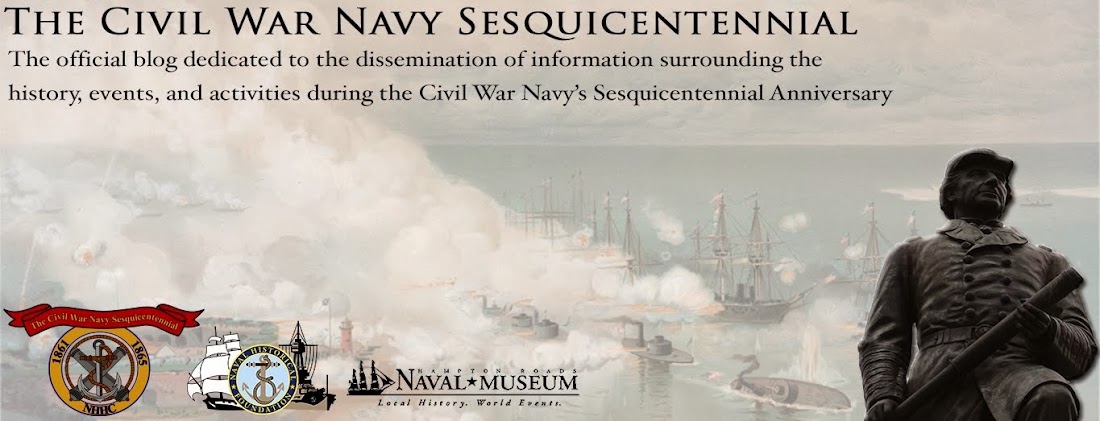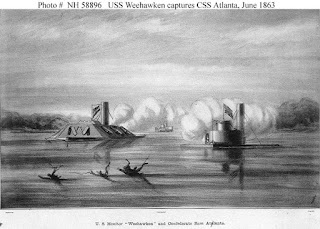On 17 June 1863, another “battle of the ironclads” was fought between the CSS Atlanta and the USS Weehawken and Nahant. This Monday marks the 150th Anniversary of that engagement. In November 1861, the Confederate steamer Fingal ran the blockade into Savannah. Afterward she was refitted as a casemated ironclad and renamed CSS Atlanta. At the time, she was considered to be the fastest, most powerful ironclad yet built by the Confederacy. The Confederates believed she could whip any ship in the Union Navy fleet. Early on the morning of 17 June, the Atlanta came steaming down the Wilmington River. She was accompanied by two other steam gunboats. Capt. John Rogers of the USS Weehawken got steam up in his Passaic-class turreted ironclad. He headed towards the Confederate ship and when in range, ordered his guns to open fire. The sister ironclad USS Nahant, under Commander John Downes, came following behind the Weehawken.
The Confederate warship got off the first shot at a range of about 1½ miles, which missed the Weehawken and landed near the Nahant, doing no damage. Rogers ordered “open fire”. After only a few shots, the Union sailors saw the Confederate colors on the Atlanta hauled down and replaced by a white flag; she had surrendered ! The Nahant never got off a shot, intending to slip by the Weehawken, run alongside the Atlanta and slug it out gun-to-gun (a.k.a. the Monitor and the Virginia). Rogers had the Weehawken approach the Atlanta and called for a boat to be sent over to his ship. Confederate Navy Lieutenant Alexander arrived shortly afterward to confirm the surrender of the CSN ironclad, and shortly after her captain, William A. Webb, came on board to deliver his sword. Rogers sent a boarding party over under the command of Lt Cdr D. B. Harmony of the Nahant, along with one of his officers and an engineer to oversee operation of the captured ship’s engine room.
For reasons we may never know, it only took five shots from the Weehawken to disable the Atlanta. Rogers went over to inspect the damage after the fight, and reported that he found they had hit the Confederate ship four times. A XV-inch cored shot “broke in the armor and the wood backing, strewing the deck with splinters, prostrating about 40 men by the concussion and wounding several by broken pieces of armor and splinters.” Another hit from a XV-inch cored shot “struck the top of the pilot house, knocking it off, wounding two pilots, and stunning the men at the wheel.” Two shots from the Weehawken’s XI-inch Dahlgren did some damage to the armor on the overhang of the casemate and shattered a “stopper” (a shield?) protecting one of the gunports. 16 Confederate seamen were wounded in the engagement, at least one died. These were cared for by the Atlanta’s surgeon, assisted by U.S. Navy surgeons, and ultimately all officers and men of the Confederate vessel were sent to Port Royal as prisoners of war.
The Atlanta was
well-armed, with two 6-inch rifles mounted in broadside and two 7-inch rifles
mounted “in pivot” at the bow and stern so they could fire in three directions.
Ammunition was described by Rogers as “a large supply”, and the ship could
reportedly do 10 knots, which was very fast for a Confederate ironclad. The
captured Confederate officers told Rogers that they believed they could take out
both Union ironclads. The captured CSN vessel was renamed the USS Atlanta and turned into a Union ironclad.
CSS/USS Atlanta after her capture. Source: Naval History and Heritage Command.
CSS/USS Atlanta after her capture. Source: Naval History and Heritage Command.



No comments:
Post a Comment